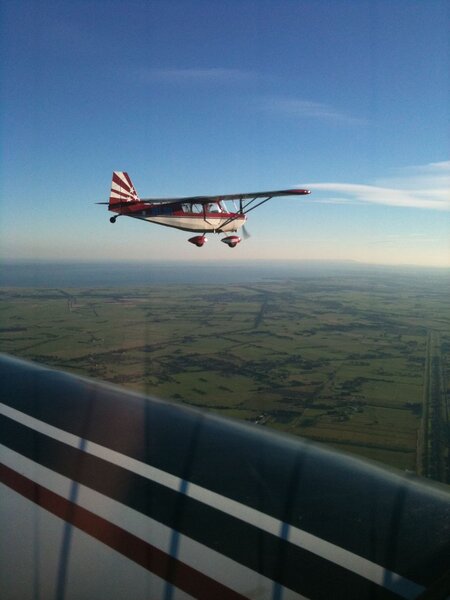-
Posts
13 -
Joined
-
Last visited
Flying Ant's Achievements

Member (1/3)
-
Dave, how much height is typically lost in a normal power off upright spin in a Pitts? Say 1 turn... open question I know
-
If I were in the market for a Citabria or Decathlon I'd definitely go with a Decathlon. I've got a little bit of time in Citabria's and flown a Decathlon twice (once with DJP in his). Fly them one after another and you won't need any more convincing. If DJP is selling his I can testify it is a very tidy aircraft in fine condition and flew very nicely... having said that we didn't go upside down.
-
It seems that spin recovery is as individual and subjective as landing techniques. It seems that there is a vast difference in what is best to teach for an unintentional emergency spin or a competition or otherwise intentional spin by someone who is practiced and expecting it. Having said that, there have been some accidents where an intentional spin has resulted in unintentional aircraft state and the pilot became confused. I was taught that if a comp spin does not recover in the expected manner, be prepared to treat it as an emergency spin and react appropriately. Because I don't do a heck of a lot of spinning I put a lot of thought into it and expect it to go wrong... which occasionally it does :big_grin:
-

Was: Aerobatic Training Camp but now a thread about nothing
Flying Ant replied to djpacro's topic in Aerobatics
The South Australian chapter are organising a min-comp/practice weekend in the next week or two and the NSW club is holding practice days at Wollongong as well. -
In relation to the A320 that flew into the trees; all high bypass engines have a significant spool up time from ilde, there is a lot of mass there that has to be accelerated and at a metered rate. That pilot was flying level with the aircraft configured for landing. He flew level waiting for alpha floor to apply TOGA thrust and it didn't because it wasn't supposed to, it was within the parameters for landing (Radio Altitude/Config). When he realised he applied TOGA thrust manually and the engines were just spooling up when he went into the trees. As an aside, you'll notice it went in wings level which contributed to the survivability of the crash... Don't get me wrong, fly by wire can go wrong and has it own limitations. Just ask the pilots of the QF72. I'm staggered that the AF447 flight data has not been recovered. Until it is all we can do is speculate. Pitot icing is interesting because we are specifically trained how to fly with unreliable airspeed indicators so I think there is more to it than that, but there always is...
-
The tail did come off an Airbus as a result of the pilots applying full rudder deflection, the aircraft was yawed then quickly the rudder was reversed which overloaded the vertical stab beyond design limits due to the side load of the airflow and the force applied by the rudder acting together. This problem is not isolated to Airbus, Boeing issued a bulletin to all operators outlining the design load capacity of the rudder and tail and pointed out that this rudder reversal technique can overstress Boeing aircraft too. In the case of a engine failure due to fuel exhaustion there is not a lot of difference between and Airbus and a Boeing. In a Boeing 767, the RAT will deploy which gives enough (but not full) hydraulic pressure to the flight controls operated by the centre hydraulic system (there are 3, Left, Centre and Right). There are no electrics from the RAT so the electrical system goes into standby power from the main battery only. In an A320/A330 etc... (I haven't flown one but just of off the phone to a friend who does) the rudder on an Airbus is always in direct law and an Airbus can be sideslipped just as well as a Boeing. In the case of a dual engine failure the RAT would supply hydraulics and electrics and the aircraft would be in direct law so there would be no flight envelope protection. On a wider note, the notion that a Boeing is better than Airbus because you can "fly" the Boeing is rubbish. Many Boeings have been mishandled and crashed as a result of being overstreed, overspeed, stalled etc... which would have been prevented in an Airbus. On the Husdon river landing, the Captain had started the APU before losing all electrics which gave him back all his protections and he landed in normal law. This allowed him to simply flare into full back stick and let the computers maintain wings level and max alpha. In the case of a dual engine failure, an A330 glides a lot better than a 767 too
-
A few more alarming regulatory changes that caught my eye were; Violating controlled airspace is now an offence of strict liability so getting lost or disorientated is not a defence. Also unless authorised by ATC, all turns when in the circuit at a controlled aerodrome must be to the left. It only offers avoiding terrain as a defence, so a right turn to adjust circuit spacing or to avoid a conflict requires ATC approval. Other than these few and far between odd regulations, I think it is a step in the right direction to have all this information consolidated into one regulatory part.
-
So I guess that the hose specifications are part of the Type Certificate or something like that and therefore doesn't apply to my experimental aircraft. DJP, all my oil hoses are Aeroquip 601 ;) Are you referring to the AD about the hose from a few years ago? Apparently the hoses don't like unleaded fuel. Is there something else about them I need to know?
-
Hi all, I'm a little stuck trying to figure something out. Where are the regulations that refer to oil/fuel hose life, overhaul and fire-sleeving requirements? I can't find an AD or any reference. Cheers,
-
In terms of importing an aircraft from the USA, I've recently done it (Nov last year) and went about it the wrong way. Send me a PM and I'd be happy to give you my spin on it. Can be very rewarding and a good prospect if you do it the right way. Cheers,
-
Yes, check out my website and see the photos. The rudder is larger than stock, I guess that would make it spin faster with a larger rudder holding it in the spin. The pilot claimed that he did not do anything different from inverted spinning any other Pitts but it was a significantly faster rotation. Can't give an objective rate of turn but from my observation from the ground it did seem a lot faster than other Pitts I've observed inverted spinning in comps. It also seemed to wind up faster i.e. there wasn't much of an incipient phase.
-
By the way djparco, I recently bought a copy of Gene Beggs' "Spinning the Pitts". Really nicely written and easy to read. Should come free with a Pitts checkout... well maybe not but a worthwhile addition to the collection. One question, my Pitts has a very high rotation rate in an inverted Spin. It recovers very easily... Not sure why.... could it be; Forward C of G? (don't think so) Larger Ailerons? (maybe if the pilot made an inadvertent input) Control rigging? (I downloaded a copy of the S1S type certificate and measured the elevator and rudder deflections... spot on) Arms too short and coming back with the stick a bit? (possibly, I was observing from the ground and the guy flying is pretty short) Any other factors that increase rotation rate in an inverted spin?
-
Spinning, a topic close to my heart. I thought I was trained on how to recover from spins until I went and did advanced spinning in a Pitts with a well regarded instructor. Then I realised I know very little and still have a lot to learn. The issue that a lot of people face, and I dare say many in the examples here, is that before you can apply the correct spin recovery you have to identify which type of spin you are in. E.g. The Pitts S2 POH states that one should use in spin aileron to recover from flat spins... where does a non-flat spin stop and a flat spin start? What if it is sort of flat? I'm not sure that I could correctly identify a flat spin from a non flat spin as per the Pitts POH definition. For a Pitts, I'm a big fan of Beggs/Muller because I don't need to know what sort of spin I'm in to use it successfully. As for other aircraft type... I can't comment.


